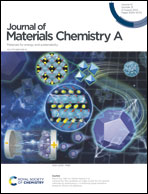Azide molecule mediated electrolyte engineering for selective photoelectrochemical azo coupling and efficient and stable water splitting†
Abstract
Low-performance and instability severely limit photoelectrochemical (PEC) water splitting and organic synthesis of photoanodes. Electrolyte regulation as a facile and scalable route receives less attention, and always requires oxygen evolution catalysts (OECs). Herein, we report azide molecule mediated electrolyte regulation to achieve OEC-free selective PEC reactions over a BiVO4 (BVO) photoanode. pH-sensitive 5-aminotetrazolium (5AT) acts as not only a substrate for the PEC azo coupling reaction but also a “liquid phase cocatalyst” to substantially facilitate charge transfer at the photoanode-electrolyte interface. In 5AT/Na2SO4 electrolyte, the azo coupling reaction occurs at pH > 4, whereas the water splitting reaction takes place at pH < 4, and polyaniline passivated BVO (BVO-PANI) exhibits a photocurrent density of 4.22 mA cm−2 at 1.23 VRHE with an onset potential of 0.34 VRHE and stable photocurrent density for 4 h. Meanwhile, 5AT as a “liquid phase cocatalyst” is universal for a variety of photoanodes, such as α-Fe2O3. Further, 5AT/NaVO3/Na2SO4 ternary electrolyte solution allows BVO-PANI to exhibit a photocurrent density of 5.1 mA cm−2 at 1.23 VRHE with an onset potential of 0.27 VRHE and stable PEC performance for 10 h. This work opens up a new avenue of electrolyte regulation to promote PEC performance and stability of photoanodes.



 Please wait while we load your content...
Please wait while we load your content...